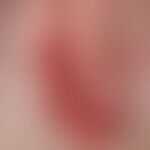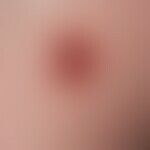Synonym(s)
HistoryThis section has been translated automatically.
Robert Willan 1757-1812
DefinitionThis section has been translated automatically.
Altogether rare, but most frequent (endogenous, more rarely exogenous) post-primary form of skin tuberculosis with normal reaction of the organism, usually not very contagious.
There is an obligation to register by name!
In 50% of the cases an association with another, active organ tuberculosis is detectable (in most cases pulmonary tuberculosis).
You might also be interested in
PathogenThis section has been translated automatically.
Mostly human, rarely bovine types of Mycobacterium tuberculosis.
Occurrence/EpidemiologyThis section has been translated automatically.
Tuberculosis cutis luposa is (in contrast to atypical mycobacterioses) only very rarely observed in large Central European dermatology centres (1:100,000 dermatological patients). More frequent occurrence in Brazil (Mann D et al. 2019). w:m=2:1.
EtiopathogenesisThis section has been translated automatically.
ManifestationThis section has been translated automatically.
mostly older people; w:m=2:1
LocalizationThis section has been translated automatically.
Mainly acral parts of the face (nose, cheeks, ears, lips), rarely extremities and mucous membranes
ClinicThis section has been translated automatically.
- Initially there is a reddish-brownish, 0.2-0.4 cm large, somewhat raised, diascopically apple-jelly-coloured n odule (lupus nodule), which is usually ignored. If not treated, peripheral spread results in a 1.0-5.0 cm large (or even larger) brown-red, symptom-free, only slightly consistency-propagated plaque with atrophic, parchment-like surface in the absence of follicle pattern (follicle destroyed by granuloma formation). Smaller satellite nodules are usually found in the marginal area, so that usually a broken marginal contour is formed instead of a smooth one
- Positive probe phenomenon or mandrin phenomenon can be triggered (only in the case of cheese making!). The clinical course depends on the immunity status of the organism. Cave! Revival of tuberculosis in immunocompromised persons.
Depending on the secondary change:- Lupus vulgaris exfoliativus with psoriasiform scalingLupus
- vulgaris verrucosusLupus
- Mucosal changes: Grey-white or glassy-transparent, mostly raised, bumpy nodules. In case of ulceration formation of soft, slightly bleeding, serous-purulent covered ulcers, corking.
HistologyThis section has been translated automatically.
- The epidermis is atrophic, more rarely acanthotic. Erosions or ulcerations are possible. Nodular infiltrates of epithelial cells, giant cells of the Langhans type mixed with a large number of lymphocytes, which can condense into a mantle around the edges of the granulomas, are present, preferably localised in the upper dermis, but also extending to the deep dermis. A central necrosis (tendency to caseate) is possible, but is often not present in young granulomas. The skin appendages in the granulomas are destroyed.
- Microscopic detection of tubercle bacilli with the common staining methods(Ziehl-Neelsen staining, Fite-staining) or by means of immunohistological methods is possible only very rarely.
Differential diagnosisThis section has been translated automatically.
Complication(s)(associated diseasesThis section has been translated automatically.
General therapyThis section has been translated automatically.
- Recurrence-free healing due to safe sterilisation
- Prevention against selection of resistant strains.
External therapyThis section has been translated automatically.
Internal therapyThis section has been translated automatically.
- Since the bacterial populations react with different sensitivities to tuberculostatics, the therapy should be designed as a triple or quadruple therapy (see Table 1). Highly effective drugs such as isoniazid or rifampicin should be included in each combination.
Notice! The monotherapy of cutaneous tuberculosis with isoniazid is obsolete!
- After the initial phase of 2 months with a quadruple therapy, treatment with two effective preparations is recommended for the subsequent stabilization phase. The detailed information on dosage, drug side effects and necessary control examinations must be observed (see in each case under the generic name). Important: The regular intake of the drugs should take place before breakfast. Rifampicin impairs the effect of anticonceptives through faster degradation.
- Immunocompromised patients with tuberculosis cutis luposa are always treated with a quadruple therapy over 12 months.
- Resistance situation: Several studies in Germany have revealed a resistance to isoniazid of 6-7% (USA 9.1%), RMP 1.5-2.4 (USA 3.9%) and EMB 1.0-1.9% (USA 2.4%). Resistance thus primarily concerns isoniazid. In these cases, antituberculostatically effective drugs that are less effective must be used.
- The risk factors for the occurrence of resistant tuberculosis pathogens are:
- Previous tuberculostatic treatment
- Insufficient tablet intake
- Stay in areas with high tuberculosis prevalence
- Stay in areas with high resistance (over 4% compared to INH)
- Contact with persons with resistant pathogens.
- The following preparations are available on the market:
- Isoniazid (e.g. Isozid Tbl., Tebesium-s-100/250 solution, Isozid Comp.)
- Rifampicin (e.g. Eremfat Filmtbl., Rifa Drg.)
- Pyrazinamide (e.g. Pyrafat Filmbl., PZA-Hefa Tbl.)
- Streptomycin (e.g. Strepto-Fatol or Strepto Hefa injection solution)
- Ethambutol (not for children under 10 years) (e.g. Myambutol Tbl., EMB-Fatol Filmtbl.).
Remember! The large number of Tbl. significantly reduces patient compliance!
The use of combination preparations simplifies the administration for the physician and the intake for the patient for the long period of the therapy, see Table 3.
Progression/forecastThis section has been translated automatically.
TablesThis section has been translated automatically.
Therapeutic strategies for skin tuberculosis (as for other extrapulmonary organ tuberculoses)
Active substance |
Dose per kg bw/day |
Month 1 |
2 |
3 |
4 |
5 |
6 |
Additionally |
|
Quadruple therapy |
Isoniazid |
5 mg |
x |
x |
x |
x |
x |
x |
30 mg Vit. B6 |
Rifampicin |
10 mg |
x |
x |
x |
x |
x |
x |
|
|
Ethambutol |
15-20 mg |
x |
x |
|
|
|
|
|
|
Pyrazinamide |
25 mg |
x |
x |
|
|
|
|
|
Combination preparations for skin tuberculosis
Generic drugs |
Example preparations |
Dose in the sample preparation |
Rifampicin + Isozianide |
Rifinah |
300/150 mg |
Rifampicin + Isozianide |
Iso-Eremfat 150 |
150/100 mg |
Iso-Eremfat 300 |
300/150 mg |
|
Rifampicin + Isozianide + Pyrazinamide |
Rifater |
120/50/300 mg |
Ethambutol + Isoniazid |
Myambutol-INH-I/-II |
500/100 mg |
300/100 mg | ||
Ethambutol + Isoniazid |
EMB-INH |
300/60 mg |
Note(s)This section has been translated automatically.
The Quantiferon-TB-Gold test has established itself as the detection method. Its valence in skin tuberculosis has not yet been proven.
The detection of mycobacteria from lesional biopsy material is important. To cultivate the mycobacteria, laboratories should always use the faster, radiometric method in addition to conventional culture.
The PCR (polymerase chain reaction) is in no case a substitute for the cultural methods.
In industrialized countries, large-area, mutating forms with broad tissue loss (mutilations of nose, ears, septum perforations, wolf's tongue, etc.) are no longer observed. Such images still adorn older textbooks, but no longer correspond to current clinical reality (cave migrant situation!).
LiteratureThis section has been translated automatically.
- Diallo R et al (1997) Lupus vulgaris as the etiology of tuberculous mastitis. Pathologist 18: 67-70
- Ghorpade A (2003) Lupus vulgaris over a tattoo mark-inoculation tuberculosis. J Eur Acad Dermatol Venereol 17: 569-571
- Mann D et al (2019) Cutaneous tuberculosis in Rio de Janeiro, Brazil: description of a series of 75cases
. Int J Dermatol doi: 10.1111/ijd.14617. - Meyer FJ et al (1995) Renaissance of tuberculosis? Internist 36: 1162-1173
- Motta A et al (2003) Lupus vulgaris developing at the site of misdiagnosed scrofuloderma. J Eur Acad Dermatol Venereol 17: 313-315
- Pandhi D et al (2001) Lupus vulgaris mimicking lichen simplex chronicus. J Dermatol 28: 369-372
- Plum G et al (1995) The Epidemiology of Multidrug Resistant Tuberculosis in the United States of America. 36: 980–986
- Senol M et al (2003) A case of lupus vulgaris with unusual location. J Dermatol 30: 566-569
Incoming links (41)
Angiolupoid; Atrophy, tight; Bateman, thomas; Blastomycosis, north american; Blastomycosis south american; Borrelia lymphocytoma; Carcinoma in lupo; Dacryocystitis tuberculosa; Epithelial cells; Finsen, niels ryberg; ... Show allOutgoing links (23)
Antituberculotic drugs ; Atrophy of the skin (overview); Carcinoma in lupo; Cutaneous tuberculosis (overview); Ethambutol; Excision; Isoniazid; Lupus erythematodes chronicus discoides; Lupus verrucosus; Nontuberculous Mycobacterioses (overview); ... Show allDisclaimer
Please ask your physician for a reliable diagnosis. This website is only meant as a reference.












